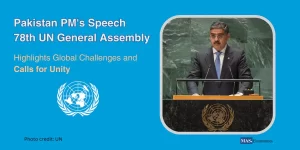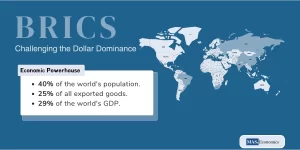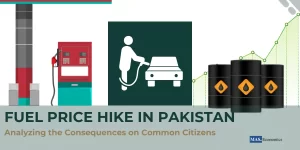Is our global economy hitting the brakes? As per the latest World Economic Outlook, the world’s economic engine is expected to shift down a gear from 3.5 percent growth last year to just 3 percent this year and 2024. Doesn’t that sound like much? Think again. This minor shift could ripple globally, leaving fewer job prospects as companies might put expansion or recruitment on hold. The result? Spiking unemployment rates and shrinking paychecks for individuals and families.
And it doesn’t stop there. As growth decelerates, the cash flow within the economy may dwindle. This could trigger a drop in consumer spending, which in turn could hit businesses hard, escalating the risk of an economic downturn. It’s a classic domino effect – a single disruption can cascade through various sectors, shaking the very foundation of economic activities.
But what’s causing this economic deceleration? The culprits are many. For starters, stringent measures to curb inflation are at play. Governments and central banks might feel compelled to tighten monetary policies like hiking interest rates to rein in soaring inflation. This could discourage borrowing and spending by businesses and individuals.
Let’s not forget the impact of recent financial turbulence and geopolitical unrest, such as Russia’s conflict with Ukraine. Such geopolitical frictions can cause trade and investment disruptions, injecting a dose of uncertainty into the global markets.
Asia’s Economy the Unsung Hero
In spite of the global economic hiccup, Asia and the Pacific region are standing tall, refusing to bow down. These regions are projected to be responsible for a whopping 70 percent of the world’s growth this year. Now isn’t that something? Particularly, China seems to be steering the global economic ship with its post-lockdown rebound. As China’s economic wheel spins faster, it fuels the demand for goods and services in its backyard and across the entire region.
Especially, China’s craving for consumption appears to be rewriting its growth story. This is a shot in the arm for businesses that export to Asia and bank on robust demand from this region.
But let’s not get carried away. While Asia’s growth paints a rosy picture amid the global economic gloom, it’s not all sunshine and rainbows. Inflation continues to be a thorn in the side of the region, potentially eating into buying power and jacking up the cost of living for individuals. Plus, some countries have pockets of financial instability and vulnerability that can’t be ignored. Keeping a close eye on these is crucial to ward off any potential economic hiccups. Now, wouldn’t you agree that’s a fair bit of food for thought?”
Bankroll for the Underdogs
Have you ever wondered about the economic safety harness that the International Monetary Fund (IMF) offers low-income nations through concessional financing? Picture this – it’s like an economic lifebuoy, thrown out to economies floundering in rough financial waters.
And the best part? These funds come with lower interest rates or, sometimes, no interest at all. A boon, wouldn’t you say, that makes financial aid more accessible during tough times.
The role of the IMF has been pivotal in aiding low-income nations to navigate the choppy waters of the pandemic and external tremors like the Russia-Ukraine conflict. This funding has been a shot in the arm for these nations, bolstering their economic resilience and driving them to adopt policies that pave the way for sustainable growth.
That being said, let’s not paint too rosy a picture. While the impact has been largely positive, there’s still a gaping need for more resources. Why, you ask? To ensure that every low-income country can bounce back robustly. Ample financing enables these nations to pump money into their economies, ramp up infrastructure, and fuel social programs that uplift their people.
G20 to the Rescue
The G20, a coalition of the world’s heavyweight economies, likes to see itself as the knight in shining armor that can solve global economic woes. They believe that by joining forces, they can grapple with thorny issues like debt crises, climate change, and sparse financing in developing nations.
Take, for example, the G20 Common Framework. It’s been hailed as a godsend for facilitating debt restructuring for countries like Zambia. This initiative has supposedly fostered harmony between creditors and debtors to create sustainable answers to debt dilemmas. Sounds good on paper, doesn’t it?
Then there’s the G20’s pledge to funnel special drawing rights (SDRs) toward poorer countries. They’d have us believe this is a grand gesture of international camaraderie. These SDRs are intended to offer extra resources to the countries that need them most, backing their efforts to get back on their feet and rebuild.
But let’s not forget we live in an interconnected world. Global challenges are like a tangled web, where one thread pulled can unravel the whole thing. So, the question remains: is this collaboration among nations indeed the magic bullet to forge a more stable and prosperous global economy or just a well-intentioned illusion?
The Labor Market Conundrum
Picture the labor market as the throbbing heart of our economies. Now imagine this heart struggling to pump blood, or in economic terms, real wages, to some parts of the body. This wage decline puts families and individuals on a tightrope, attempting to keep their standard of living from tumbling while prices for goods and services continue to soar. Not an easy feat, is it?
Now, what’s causing this wage slide? The culprits are plenty – raging inflation and sluggish economic growth, to name a couple. Inflation, that old nemesis, gnaws at the purchasing power of wages, making it tougher for people to afford the same goods and services they once did. Ouch!
But let’s not wallow in doom and gloom. There’s a silver lining – robust labor markets, marked by low unemployment rates and increased employment. These are the lifeblood of economic growth, pumping up consumer spending, which in turn drives demand for goods and services and kick-starts economic activity. Sounds promising, doesn’t it?
However, navigating these choppy economic waters is no cakewalk. Policymakers have to walk a tightrope, balancing the needs of the labor markets with the need to keep inflation on a leash. This calls for a deft hand at managing monetary and fiscal policies to ensure economic stability and foster sustainable growth. Quite the juggling act, wouldn’t you agree?
Final Thoughts
The global economy – it’s a tangled mess of interconnected variables, and its performance swings like a pendulum, impacting lives across the globe. Sluggish growth, Asia’s stubborn tenacity, the safety net of concessional financing, the G20’s ‘all-in-this-together’ mantra, and the labor market’s ever-changing dance play a role in weaving our economic tapestry. But are these threads as sturdy as we believe?
Understanding these trends and hurdles is crucial. Or so they say. It equips us – the common folk, the business moguls, the policymakers – with the power to make well-informed decisions. Could we, then, navigate this chaotic sea of the global economy towards a prosperous shore, ensuring a future that’s not just bright but blindingly radiant for all?
So, let’s not hit pause. Let’s continue to probe, learn, and engage with the economic beast. After all, who doesn’t fancy a world filled with shared opportunities and mutual prosperity? But remember, in the world of economics, not everything that glitters is gold until we dive back into these murky waters, dear readers!




